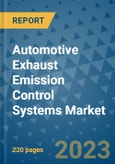Tailpipe emissions caused by ICE vehicles is one of the major contributors to global pollution levels. The release of harmful gases such as carbon monoxide (CO), carbon dioxide (CO2), nitrogen oxides (NOX) and particulate matter cause various respiratory issues among the public while triggering rise in temperatures due to their heat-absorption properties. These factors have been an area of concern for environmental organizations throughout the world. This has led to innovations and regulations to curtail tailpipe emissions and has helped in the creation of demand across the sector.
Although electric and hydrogen mobility have caught up drastically in terms of real-life implications and adoption, ICE vehicles are still expected to be in majority for the next 30 years. These factors are a testimony to the lucrative opportunities floating in the global automotive exhaust emission control systems market.
ICE Vehicle Regulations to Play an Underhanded Role in Market Expansion
Vehicular emissions from ICE vehicles have been under increasing scrutiny via strict regulations. Constant tweaks in the Clean Air Act, the introduction of Euro 6, BS4 and BS 6, and test methods like worldwide harmonised light vehicle test procedure (WLTP), and real driving emissions (RDE) further the agenda. These factors drive auto manufacturers to adapt and innovate emission control systems as per the regulations, thus pushing the demand in the automotive exhaust emission control systems market.
Some of the prominent names pertaining to the global automotive exhaust emission control systems market are Calsonic Kansei Corporation, Faurecia, DENSO Corporation, Eberspacher Climate Control Systems GmbH & Co., and Continental Emitech GmbH Friedrich Boysen GmbH & Co. KG.
Although electric and hydrogen mobility have caught up drastically in terms of real-life implications and adoption, ICE vehicles are still expected to be in majority for the next 30 years. These factors are a testimony to the lucrative opportunities floating in the global automotive exhaust emission control systems market.
COVID-19 Induced Production Stagnation, Onset of Recovery Likely in the Next Couple of Years
During the coronavirus pandemic, global supply chains were heavily disrupted. This led to a slowdown in the production and supply of automobiles - a sector that heavily relies on a globally diverse supply chain. In the year 2020, automotive heavyweights such as Fiat, Volkswagen, General Motors, and BMW even had to suspend their production. As of today, the production and supply have slowly gained momentum, thanks to vaccine efforts. As for the recovery, pre-COVID production numbers are not expected to be hit until the year 2023 as per estimates. It is, however, logical to expect a post-pandemic boom in sale of automobiles, giving a thrust to the automotive exhaust emission control systems market.ICE Vehicle Regulations to Play an Underhanded Role in Market Expansion
Vehicular emissions from ICE vehicles have been under increasing scrutiny via strict regulations. Constant tweaks in the Clean Air Act, the introduction of Euro 6, BS4 and BS 6, and test methods like worldwide harmonised light vehicle test procedure (WLTP), and real driving emissions (RDE) further the agenda. These factors drive auto manufacturers to adapt and innovate emission control systems as per the regulations, thus pushing the demand in the automotive exhaust emission control systems market.
Catalytic Converters Emerge as a Popular Emission Control System
Over the years, various emission control systems have been developed to be used as alternatives or in combination to achieve the desired emission levels. The most common exhaust emission control devices are catalytic converters, amounting to almost 50% share of the automotive exhaust emission control systems market globally. It chemically cleanses tailpipe emissions before they are released into the environment. Other solutions include diesel particulate filter, diesel oxidation catalyst, selective catalytic reduction, and three-way catalytic converters.Economic Growth in Asia Pacific to Lead to Augur Automobile Buying Propensity
Several Asian countries have witnessed significant growth in the automotive sector, especially China, as it has grown up to become the world’s largest automotive market. This is mainly due to the countries’ manufacturing prowess, steady economic growth, and personal mobility adoption. The by-product of this trend is an increase in demand in the emission control systems market and prospects for local manufacturing and assembly of catalytic converters locally.Some of the prominent names pertaining to the global automotive exhaust emission control systems market are Calsonic Kansei Corporation, Faurecia, DENSO Corporation, Eberspacher Climate Control Systems GmbH & Co., and Continental Emitech GmbH Friedrich Boysen GmbH & Co. KG.
Table of Contents
1. Executive Summary
2. Market Overview
3. Price Trends Analysis and Future Projects
4. Global Automotive Exhaust Emission Control Systems Market Outlook, 2019 - 2030
5. North America Automotive Exhaust Emission Control Systems Market Outlook, 2019 - 2030
6. Europe Automotive Exhaust Emission Control Systems Market Outlook, 2019 - 2030
7. Asia Pacific Automotive Exhaust Emission Control Systems Market Outlook, 2019 - 2030
8. Latin America Automotive Exhaust Emission Control Systems Market Outlook, 2019 - 2030
9. Middle East & Africa Automotive Exhaust Emission Control Systems Market Outlook, 2019 - 2030
10. Competitive Landscape
11. Appendix
Companies Mentioned
- Johnson Matthey
- BASF SE
- Tenneco Inc.
- BENTELER International AG
- Umicore
- Eberspächer
- SEJONG INDUSTRIAL Co., Ltd.
- BOSAL
- Klarius Products Ltd.
- Faurecia
- Vitesco Technologies GmbH
- Albonair GmbH
Methodology

LOADING...








